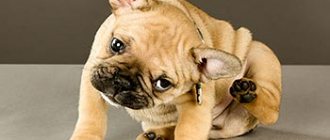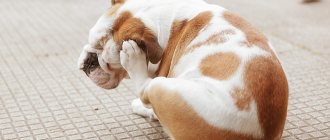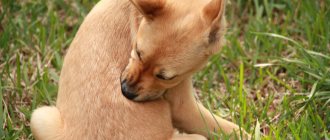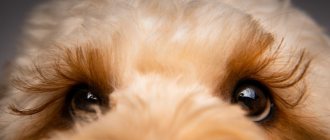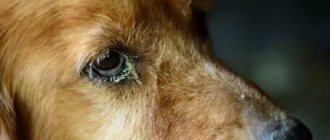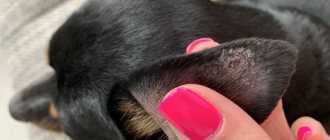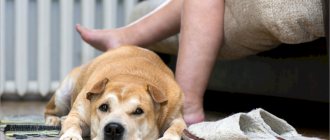Itching in a dog is an unpleasant phenomenon, accompanied by severe scratching. It is not an independent disease, but only acts as a symptom, warning about the danger. If your pet constantly scratches its body, then without timely help it will tear off its skin. Numerous injuries will lead to secondary infection and aggravate the existing problem.
Possible reasons
Most often, itchy dermatitis is caused by ectoparasites. But what to do when your dog itches a lot but doesn’t have fleas? The owner takes care of the pet, regularly treats the skin with insecticidal sprays or drops, but pruritus bothers the dog. Insect attacks most often occur in the summer, but the animal itches even in cold weather, when there are no fleas. The following factors cause itching are distinguished:
- Stress.
- Injuries.
- Contact with irritants.
- Exposure to heat or cold.
- Parasites.
- Allergy.
- Infection.
In all cases, when eliminating itchy dermatitis, in addition to specific medications, antibacterial agents, as well as antimycotics, will be required.
What to do if your dog is itching
In case of severe itching, to provide quick help, it is necessary to lubricate the affected area with anesthetic ointment. To alleviate the condition, your pet can be given an antihistamine, calculated strictly by weight.
But before you begin treatment, you need to understand why this happens. You should carefully examine the animal for the presence of blood-sucking parasites and analyze its diet (consumption of foods that can cause allergies). It is also necessary to remove all objects and chemicals that cause irritation.
If skin itching and damage to the surface of the body appears, as well as a deterioration in the general condition, it is necessary to show your pet to a veterinary dermatologist as soon as possible.
Self-administration of medications without a doctor's prescription can lead to increased skin itching and serious consequences. Long-term inflammatory reactions, infection of scratches and abrasions on the body cause the development of sepsis, severe complications and death of the pet.
To prevent such problems, you should treat your pet from blood-sucking parasites (if necessary), maintain hygiene, feed the animal properly (excluding allergens), avoid contact with irritating substances, and undergo medical examination by a veterinarian once a year to identify pathologies of internal organs.
Stress
Dogs, especially puppies, are impressionable creatures. After purchase, the baby is brought to a new home. Everything is unusual: the food, the decor, the people around you. The pet experiences a feeling of itchy skin. The puppy is itching, but there are no fleas.
Similar symptoms are observed in adults during or after an expert exhibition. Some dogs do not cope well with travel and transportation. An inadequate reaction to changes in living conditions also occurs in adult dogs. Transferring from a kennel to an apartment or vice versa causes a feeling of confusion. There are individual and breed predispositions to stress.
The irritated condition in most cases goes away without treatment, the itching stops spontaneously. However, the dog owner needs to watch the pet. If you notice that your dog reacts violently to changes in the environment, Stop Stress or Kot Bayun medications can help. They should be taken 5 days before the expected event and for the same time after.
Check out our review of sedatives for dogs.
Adviсe
To summarize, here are some final tips regarding the issue of itching in dogs:
- When the first symptoms appear, you should urgently visit a specialist and not self-medicate. Itching in most cases is only one of the symptoms, and not an independent disease, and only a veterinarian can make an accurate diagnosis. The sooner this is done, the better, since most ailments are much easier to treat in the initial stages.
- When treating dogs externally, the product should be applied to places where the pet cannot reach and lick it off its fur. For the same reason, isolation from other animals is also required.
- One of the main symptoms that occurs in parallel with itching, which should alert the owner, is an increase in the amount of water consumed. Other factors that require attention are the appearance of unpleasant odors and changes in the pet's behavior.
- If the itching was caused by parasites or fungal growths, then not only treatment of the dog is required, but also disinfection of the entire apartment and pet care items, otherwise relapses are possible.
- If there is any damage on the surface of the skin caused by scratching or other reasons, then it is not allowed to carry out water procedures using shampoo without obtaining permission from a specialist, since this can only increase inflammation and itching.
Injuries and wounds
The skin around the affected area becomes hyperemic, swollen, and itchy. Ulcers form. The dog scratches the sore spot, the pathological surface expands. If your dog has had surgery, the healing stitch may also be itchy. Help consists in the destruction of microflora, the waste products of which cause pruritis.
I recommend Terramycin.
Use an antiseptic aerosol. If the itchy areas are covered with hair, cut it off and treat the wound surface with a spray as needed. Terramycin spray, Alamicin, and other antiseptics are in demand.
Contact with irritants
Indoor dogs are regularly treated with insecticides, because ectoparasites plague not only pets. The animal does not have fleas, but it is constantly itching. It is necessary to analyze what physical or chemical irritants can cause itching.
In winter, the decorative dog lives close to heating radiators. The skin dries out and cracks. Skin defects are inseminated by the microflora that constantly lives on the dog, and dermatitis develops. They use aerosol antiseptics and move the dog’s den away from the battery.
Excessive care for your pet leads to the opposite result. Bathing with a low-quality detergent dries out the skin and causes pruritis. If you frequently bathe your pet with a good shampoo, he will also develop itchy dermatitis. The protective fat layer is washed off from the surface of the skin, as well as hairs. The hairs break, the skin dries out. Dogs do not need to be bathed unless they are very dirty.
Most situations do not require drug treatment. Recovery occurs after the causes are eliminated.
Skin fold dermatitis
Skinfold dermatitis is an inflammatory condition found in skin that is in close contact with adjacent skin. In this case, there is local damage to the skin due to friction, inflammation, which leads to swelling and secondary infection. Symptoms:
- Lip fold dermatitis occurs due to excess skin of the lower lip overlapping each other. Excess skin forms cracks that allow food particles and saliva to enter, creating an ideal environment for bacterial growth. The resulting superficial skin infection creates a foul odor, which most owners mistake for an odor due to dental disease.
- Facial fold dermatitis is more common in Pekingese, English Bulldogs and Pugs. The areas between the folds of skin at the back of the nose and under the eyes become swollen and inflamed due to lacrimation or the accumulation of secretions from the sebaceous and apocrine glands. Secondary bacterial infection may occur.
- Genital fold dermatitis is more common in obese animals, which have small external genitalia deep within folds of nearby skin. Urination causes irritation and maceration of the surrounding skin, leading to severe inflammation, secondary bacterial infection and, sometimes, ulceration. Sick animals exhibit increased licking of the external genitalia and this is usually the primary concern of owners.
- Tail fold dermatitis is more common in English bulldogs, Boston terriers and pugs. This dermatitis occurs due to the pressure and movement of their curved tail on the skin, as well as the swelling that may occur in the folds of skin near the tail.
- Body fold dermatitis occurs in animals that have excess skin that gathers in folds (for example, Basset Hound and Shar Pei). The folds are most often found in the area of the paws and torso. As with other fold dermatitis, rubbing of surface secretions leads to inflammation and secondary infection of the skin.
Treatment:
1. A weight loss program should be started if the dog is obese.
2. Cleansing wipes (eg baby wipes, tampons, chlorhexidine containing wipes, other antimicrobial wipes) applied every 12 to 72 hours work very well.
3. Alternatively, standard topical treatment may be used to control skin problems. For facial, caudal, lip, and vulvar dermatitis, the affected area should be cleansed every 1 to 3 days, as needed, with antibacterial shampoos containing chlorhexidine, benzoyl peroxide, or ethyl lactate.
4. Topical application of antibiotic ointments, solutions or sprays every 24 hours for the first 5-7 days.
5. Any concomitant disease (eg corneal ulcer, dental disease, gingivitis, urinary tract infection) must be treated.
6. Surgical removal of excess folds in the muzzle, lips, or vulva, or amputation of the tail if fold dermatitis is present, is usually effective.
7. The prognosis is good, but lifelong local treatment may be necessary if surgical correction is not performed.
============================================================================================================================================================================================
Exposure to heat or cold
The dog licks the burned or frostbitten surface. Acral dermatitis develops. Decomposition products of dying tissues cause intoxication. are not enough for this treatment . Invite a veterinarian and administer antibiotic therapy under his supervision. The specialist decides which drugs to use and how to administer them - orally, intramuscularly or subcutaneously.
In the hot sun, the skin dries out and bursts. The microflora, which is ubiquitous, is activated. The slightest abrasion or mosquito bite opens the gates for infection, pustules form, and itchy pyoderma develops.
The affected surface is treated with an antiseptic spray. For prevention, cooling scarves, blankets or mats are used. Do not put wet cloth on your dog. Slowly evaporating moisture overcools the pet and causes pneumonia. If the air conditioner is on, the dog is placed in another room and the door is closed to avoid drafts, which can also cause pneumonia.
Dogs can only be bathed in clean waters. Otherwise, the microflora rapidly developing in warm water will begin to develop on the dog’s skin, causing itching.
Cooling gussets are provided for hot weather.
Diagnosis of itching
The veterinarian will begin the diagnosis by collecting information about the dog's lifestyle. It is important for the doctor to know what the dog usually eats, errors in nutrition (food from the table, treats), as well as treatment of the dog for parasites. Typically the diagnostic plan is as follows:
- Anamnesis collection.
- Examination of the dog.
- Local inspection of scratching areas.
- Biochemical and clinical blood tests.
- Taking a scraping from the itchy area.
The diagnostic and treatment plan may change at the discretion of the doctor. Sometimes the solution to the problem lies on the surface, and the veterinarian can immediately answer why the dog’s back is itchy at the tail, and what to do about it. Your task is to strictly follow the instructions and listen to the recommendations of your doctor.
Parasites
Pruritis is a symptom of a dog being infected with subcutaneous mites and nematodes . Clinical signs appear primarily in puppies and older dogs with weakened immune systems. Short-haired dogs get sick more often than long-haired dogs. Animals kept in unsatisfactory conditions and receiving unbalanced feeding are predisposed to illness. The peak of the disease is observed in the warm half of the year.
Demodexes are permanent inhabitants of dog skin. They inhabit sebaceous glands, hair follicles, and eat their contents. In animals with a strained immune system, clinical signs of the disease do not occur. Scabies is accompanied by dermatitis. The scratched surface becomes infected with microbes.
Treatment is developing in the following areas:
- Destruction of parasites . The wool is cut. Use external acaricidal preparations based on amitraz at weekly intervals. Pesticides eliminate sexually mature individuals. The eggs hatch into larvae that must be destroyed before they become sexually mature. The course of treatment consists of 3-5 treatments. An alternative is acaricidal tablets Milbemycin or Sayfli. They are safe and easy to use. But the course of treatment continues for months.
- Elimination of symptoms of dermatitis . Bacteria and fungi develop on damaged skin, which are ubiquitous. Therefore, antibiotics are used in combination with antimycotics.
- Immune stimulation . The injection agents used are Gamavit, Katozal, Phosprenil, Maxidin.
Ticks that cause sarcoptic mange, notoedrosis and otodectosis get on the skin of dogs with weakened immune systems through contact with cats or stray relatives. The principle of treatment is the same as for demodicosis. Notoedrosis is mild and often ends with spontaneous recovery. Otodectosis is characterized by damage only to the inner side of the ear. Experts consider Surolan, which is instilled into both ear canals, to be an effective drug for treating ear mites.
High infestation with nematodes is characterized by skin rashes, disheveled fur, and baldness. Parasitic worms consume all the vitamins supplied with food, block their absorption from the intestines, and release metabolic waste into the blood.
Treatment consists of deworming. Use Dirofen, Drontal or Kanikvantel. Dying parasites secrete poisons, so detoxicants are used.
Parasitic diseases and associated financial expenses for treatment can be avoided in the following ways:
- feed and maintain the dog in accordance with veterinary and sanitary requirements;
- carry out quarterly deworming;
- limit contact with stray animals.
Pododermatitis
Pododermatitis is an inflammation of the delicate skin of the paws between the toes.
It occurs most often between October and March, when roads and paths are sprinkled with the reagent. As a rule, this is salt, but reagents with added chemicals are most often used.
The most susceptible breeds are those with short hair and often without undercoat (Dobermans, Great Danes, Shepherds, Bulldogs, Pinschers, Toy Terriers, Chihuahuas, etc.).
Symptoms:
— The dog constantly licks its paws, chews them, and limps.
— Paw pads are red and wet.
— The disease manifests itself as sores on the pads.
- Vesicles filled with blood form on the paws.
- A characteristic sign is swelling of the paws.
Treatment:
1. First of all, you don’t need to wash your paws with an alkaline solution every time you walk: soap, shampoo or gel. With this treatment, the skin becomes susceptible not only to reagents, but also to pathogenic bacteria, and this can lead to more serious diseases.
2. Antiseptics and antibacterial agents are prescribed for treatment.
Prevention:
— Before a walk, rub the pads with paraffin or a special product that is sold at a veterinary pharmacy.
— After a walk, wash off the reagent and all dirt with running water, without any means.
- Use shoes for animals.
============================================================================================================================================================================================
Allergy
Immune bodies protect the body from foreign proteins. Protective cells compare the structures of proteins received from outside with their own. If they do not match, a violent inflammatory reaction destroys the alien. When the foreigner recognition mechanism fails, an allergic response develops. Cells mistake harmless compounds for virulent ones.
A dog with a damaged immune system experiences reactions characterized by dermatitis, swelling, and conjunctivitis. If your pet itches frequently, but no fleas are found on its skin, an allergy is suspected.
An inadequate response to stimuli occurs for the following reasons:
- side effects of medications;
- response to external stimuli (atopic dermatitis);
- feed allergy.
Side effects of medications
Skin itching is the least evil that occurs as a side effect of medications. Typically, a reaction occurs to the use of medicinal serums and antibiotics. If your dog is itching, you need to find out what medications he is taking and stop them . To relieve allergy symptoms, antihistamines are used - Suprastin; Tavegil; Diphenhydramine.
Prevention of disease is the responsibility of the veterinarian prescribing treatment. The use of drugs with side effects should be avoided, and if this is not possible, oral therapeutic forms should be preferred to parenteral ones.
Atopic dermatitis
Difficult to diagnose. However, attentive dog breeders note that the acacia tree has bloomed and their beloved dog is itching. The owner used new perfume, a friend came and lit a cigarette - the dog started having problems.
Atopic dermatitis
An allergic response can occur to household chemicals, plant protection products, the smell of gasoline, indoor plants, cat hair, and street dust. Antihistamines provide only momentary relief. You can get rid of the disease if you give up your own habits and interrupt your pet’s contact with the allergen. It’s painstaking work, but the pet’s health is more important.
Feed allergy
I remember an interesting incident. A big man with a Caucasian Shepherd puppy in his arms visited the Kennel Club. The baby was 4 months old, weighed 25 kilograms. His whole face was covered in acne. The owner worked as a cook in a restaurant for sailors, fed the pet table scraps and wondered why the puppy had dermatitis. They explained to him that the cause of the illness was spices.
If you give your dog human food, be careful. Adherents of natural food need to be prepared for the fact that the pet will react to any component of the food. It is difficult to identify the irritant.
The use of ready-made feed mixtures can also have a negative impact. Therefore, change feed gradually. On the first day, mix 1/4 of the new food with 3/4 of the old. The next day, the portion of replacement food is increased. Most often, an allergic response occurs to chicken meat. Therefore, choose a recipe with duck, fish or lamb.
If such a change in diet does not help, use Hill's z/d or Royal Canin Anallergenic therapeutic food for dogs with food allergies and intolerance to food components.
How does itching appear in dogs?
It's quite easy to suspect something is wrong. The dog constantly itches and chews itself in a certain area or throughout the body. Due to unpleasant sensations, she sleeps poorly and refuses games and favorite treats. Appetite decreases, which quickly affects weight. The hair gradually falls out until some areas become completely bald. The skin becomes red and inflamed.
The probable cause of itching in a dog can be determined by its location. Active scratching of the ears indicates a high probability of otodectosis. If your pet rubs all parts of its body against furniture and rolls around on the floor, it may suffer from a skin disease or an allergic reaction. Regardless of the cause, treatment is carried out only after diagnosis in a veterinary clinic.
Infection
Infectious diseases are rarely the main cause of pruritic dermatitis. Conditionally pathogenic fungi and bacteria always live on the skin of dogs, but are activated only when the immune defense fails. The main reasons are unsanitary conditions and unbalanced feeding.
Intradermal mites gnaw passages and destroy capillaries. The ichor emerges - an ideal breeding ground for microbes. Uncontrolled use of antibiotics destroys bacteria - the main competitors of microscopic fungi. We discussed above how to resist bacterial infections. But what to do if fungi become active?
Most often, infectious diseases of mycotic etiology are called ringworm. Accurate diagnosis is carried out in the clinic. If the pathological focus occupies a limited area, ointments are used - Yam, Clotrimazole or Mycozon. Aerosols - Exoderil or Fungin - are considered more convenient means.
In case of large-scale lesions, the dog is bathed in a solution of Fucoricin or Imaverol. In severe situations, take Griseofulvin tablets.
On topic: The dog has red spots on its stomach.
Dermatophytosis (lichen)
Dermatophytoses are infectious diseases of keratinized tissues (skin, hair, nails) caused by fungi of the Microsporum, Trichophiton or Epidermophiton species.
LOCALIZATION PLACES
In everyday life, all these diseases are called lichen. Ringworm is transmitted to humans!
There are several types of dermatophytoses, similar in symptoms:
- ringworm;
- trichophytosis;
- microsporia;
- favus.
Symptoms:
1. Peeling of the skin with signs of hair loss.
2. Inflammatory process on the skin, sometimes with purulent discharge.
3. Itching.
4. Baldness.
Treatment:
1. For small lesions, ointments are used
2. Lime sulfur solution; miconazole solution; povidine iodide; rinsing solutions containing chlorhexidine. The dog's ears are treated separately using cotton swabs.
3. In especially severe cases, when large areas of the body are affected, fulcin, grisin and biogrisin are used.
============================================================================================================================================================================================
Prevention
Prevention is better than cure in moral and material terms. I will tell you what needs to be done to minimize the risk of developing the disease. Fulfill the following conditions:
- Ensure that the living conditions comply with sanitary standards. The optimal air temperature is 15-16°C, humidity is from 40 to 70%.
- Natural food is better than prepared food, provided that the diet is balanced in nutrients and energy. In practice this is difficult to achieve. Recipes from the Internet are not suitable because the actual nutritional content of the ingredients may differ from those given in the recipe. Therefore, use factory-made food . If your dog has a food allergy, appropriate nutrition is always an option.
- quarterly deworming .
- Avoid bathing your pet with detergents.
- In hot weather, use cooling mats, scarves, or blankets.
- In the presence of a dog, do not smoke, do not use perfumes, and prevent your pet from coming into contact with household chemicals.
Pathology of the sebaceous glands
The scientific term is hyperfunction of the sebaceous glands. It occurs more often in cats, but dogs are no exception. The placement of the sebaceous glands resembles a black rosary around the base of the tail, sometimes on its upper surface. Dark spots, matted fur, the formation of oily seborrhea, painful itching are signs of pathology.
The animal feels severe discomfort:
- tries to chew the tail;
- spinning on his butt;
- licks the affected areas.
All these manipulations can injure the tail, causing baldness. To save your pet, specialized products are used, often shampoos. They regulate the functions of the exocrine glands.
